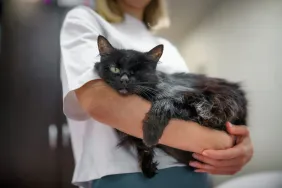Neuroaxonal dystrophy in cats is an inherited condition that causes a cat’s brain to degenerate. This condition can affect most cats; although, cats usually develop it after they reach at least five weeks of age.
Unfortunately, the cause is unknown, and there is no current cure for the condition.
If you see signs that your feline might be suffering from brain cell degeneration, then you must consult your veterinarian for a proper diagnosis and course of treatment. Here’s what you should know about the symptoms, causes, and treatments of neuroaxonal dystrophy in cats.
Symptoms Of Neuroaxonal Dystrophy In Cats
Neuroaxonal dystrophy in cats can result in a number of symptoms determined by which part of a cat’s brain have been affected. Some of the most common symptoms include:
- Seeming uncoordinated
- Swaying
- Tremors of the head and neck
- Staring vacantly
- Tilting their head
- Loss of appetite
- Avoiding the litter box
Causes Of Neuroaxonal Dystrophy In Cats

The precise underlying cause of neuroaxonal dystrophy in cats unfortunately unknown.
In general, the condition seems to set in after a cat reaches at least five weeks of age.
Veterinary Treatments
If you worry that your cat might be developing neuroaxonal dystrophy, then your veterinarian will want to carry out a full physical examination. They’ll order blood and urine tests. They may use X-rays of the brain to see if any tumors are present.
A key part of forming a diagnosis is to rule out other medical conditions that might produce similar symptoms.
Unfortunately, there is no current cure for this condition.
The vet may prescribe antibiotics and anti-anxiety medication as a course of treatment. As ever, if your vet prescribes any medicine for your feline, then it is vital that you stick to the precise dosage and frequency instructions along with completing the full course of medication.
Following a diagnosis, it is important that your cat keeps up regular visits to their vet to monitor the condition and their general health. Additionally, your vet might suggest some dietary changes for your cat in a bid to improve their quality of life.
Has your cat developed neuroaxonal dystrophy? How are you and your vet keeping your cat comfortable? Tell us all about it in the comments below.









